I’ve read Ruth Rendell in the past, but the name of the particular work now escapes me. What didn’t escape me was her beautiful writing, attention to detail, and carefully considered plots. The Child’s Child is Ruth Rendell’s latest novel written pseudonymously as Barbara Vine. Intriguing from the start, I have mixed feelings as I consider the novel at its conclusion. It is that clever creation, the novel within a novel, and therein is at least some of the problem.
The opening story is that of Grace and Andrew Easton, adult siblings who have enjoyed a close relationship throughout their lives. Upon their grandmother’s death, they set up housekeeping in the well-appointed London home she has jointly left them, giving little thought to what will happen when either of them is in a relationship. Andrew soon takes up with James, a wealthy writer who is charming, but also taciturn and difficult by turns. James quickly becomes a fixture in the house, spoiling the tranquil atmosphere when he criticizes and ridicules Grace’s research into women’s rights because he feels she isn’t sensitive enough to the even worse plight suffered by homosexual men and women. Grace attempts to keep the peace by focusing on her thesis and reviewing a manuscript from the previous century provided by a friend called The Child’s Child. The manuscript eerily mirrors her own tense living arrangements, with friction between a cohabitating brother and sister when the brother’s lover also sets up house with them.
Writing two novels in one is a tricky proposition, much like writing from multiple character perspectives – there is a balance to be struck and a management of expectations to be negotiated between the two narratives. What does one have to do with the other? How are both stories enhanced or complementary to each other? How does the author maintain interest in both while the focus is on one of them at a time? Here, both ‘novels’ are well written and engaging, with both similar themes and studied differences preventing them from being redundant. They worked well in tandem with each other, but I found the main story to be much more compelling (as I am sure other readers might think just the opposite!). That might have been less problematic had the first part ended in a more muted cliffhanger, and had the second ‘novel’ not been so much longer than the first one. Vine leaves little more than twenty pages to wrap up her original, and as a result the ending seemed rather rushed and unsatisfying – not to mention that after a while I wanted to rush the second story to find out what happened with the first one. I got the feeling that the story within the story was really the one that she wanted to write, and while both complement each other, they also felt incidental to each other as well.
The Child’s Child is a complex psychological portrait of sibling relationships, young unmarried mothers and gay relationships across time, mixing up a thick stew of betrayal among family in the community. It illustrates that harrowing choices and consequences placed on those living outside society’s mores. There are both observant comparisons being made by the writer and to be drawn by the reader. A stronger balance between the novels would have made this a more satisfying read for me, but anyone interested in thought-provoking and suspenseful historical fiction mixed with a handful of literary musings will find much here to enjoy.



